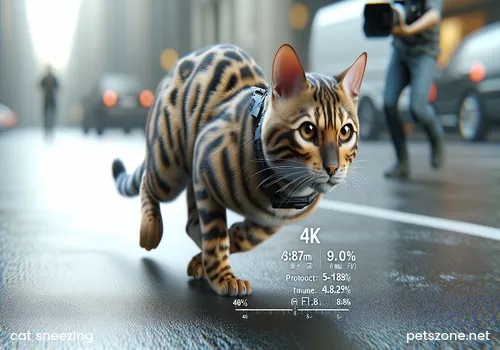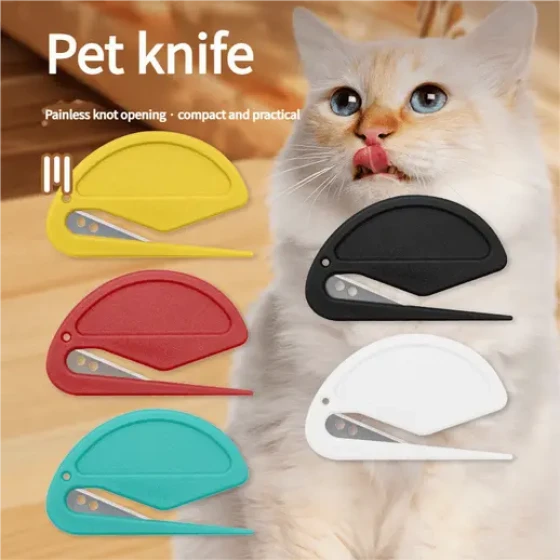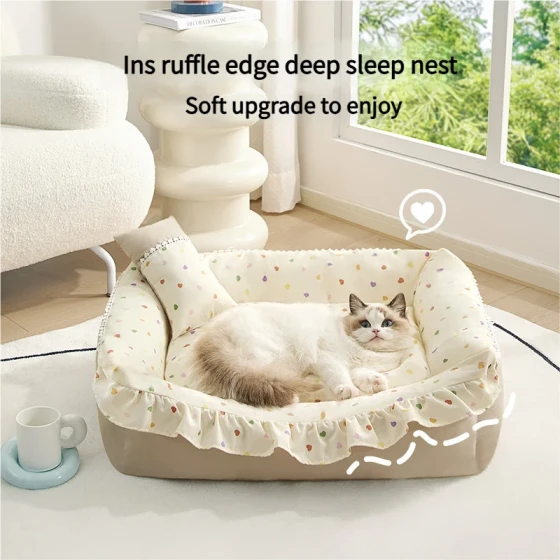Cat Sneezing with More Eye Discharge but Good Spirit_Do These Cat Symptoms Need Attention
When a cat sneezes and has increased eye discharge but still maintains good spirit, many pet owners may be confused: is this a minor issue, or a warning sign? Don’t rush; this is indeed a common condition in cat health, but the causes can range from minor to serious, and it is worth our in-depth understanding.

Generally speaking, cat sneezing and increased eye discharge are often related to upper respiratory tract infections, much like a human cold. However, the cat’s spirit is an important indicator of illness severity. If the cat sneezes and has eye discharge but is still lively and has a normal appetite, it usually means the condition is mild, possibly just a common viral infection or a slight stress reaction to the environment.
But we should not be careless, as even cats with good spirits may show these symptoms as early signs of certain diseases, such as feline herpesvirus, calicivirus, or chlamydia infection. Understanding these potential causes helps us better observe and care for cats and seek veterinary help when needed.
Possible Reasons for Cat Sneezing, More Eye Discharge but Good Spirit
When a cat shows sneezing and increased eye discharge, even if its spirit is good, there may be several causes. Knowing these reasons can help us better assess the situation.
1. Mild Upper Respiratory Tract Infection (Cat "Mild Cold")
This is one of the most common reasons. Just as humans sometimes sneeze or have a runny nose, cats may also have mild upper respiratory symptoms caused by viral or bacterial infections. Common pathogens include feline herpesvirus and calicivirus, which are the main causes of cat upper respiratory infections and account for up to 90%.
In such cases, cats may sneeze, have a runny nose (which may be clear or turn yellow or green and sticky as the illness progresses), watery eyes, or increased eye discharge. Because it is a mild infection, the cat’s immune system actively fights it, so their spirit and appetite usually remain good; they still love to play and eat and may even clean their own eye and nasal secretions. With good rest and care, this mild infection often improves on its own within one to two weeks.
2. Environmental Irritants or Allergies
Cats’ noses and eyes are very sensitive to environmental irritants. Dust, pollen, perfume, cleaning agents, cat litter dust, and even secondhand smoke can irritate the cat’s respiratory mucosa, causing sneezing. At the same time, the eyes may become irritated and secrete more discharge. If the cat only sneezes and has eye discharge after exposure to certain environments or substances without other symptoms, environmental irritants or allergies are likely.
These symptoms are usually temporary; once the irritants are removed or the environment improves, symptoms will ease. The cat’s spirit usually remains unaffected.
3. Chronic Rhinitis or Sinusitis
If a cat’s sneezing and nasal secretions repeatedly appear or last a long time, even if its spirit is okay, chronic rhinitis or sinusitis should be considered. Chronic rhinitis may result from untreated acute upper respiratory infections or irreversible damage to nasal mucosa by viral infections. This makes the cat’s nasal cavity more prone to irritation or secondary bacterial infections, causing persistent nasal secretions (which may be watery or mucopurulent) and sneezing.
4. Chlamydia Infection
Feline chlamydia infection is another possible cause of eye and respiratory symptoms in cats. Chlamydia is a microorganism between bacteria and viruses, mainly causing eye infections characterized by conjunctival redness, increased eye discharge (initially watery, later possibly sticky yellow), sometimes accompanied by mild sneezing and nasal discharge. Unlike viral infections such as feline calicivirus, systemic symptoms caused by chlamydia infection are usually mild; cats may remain energetic with a good appetite.
5. Other Less Common Causes
Although relatively rare, sneezing and increased eye discharge may also be caused by other reasons, such as foreign bodies in the nasal cavity (e.g., grass seeds), nasal polyps, tumors, or even tooth root infections. These cases may be accompanied by other symptoms, such as facial swelling, breathing difficulty, bad breath, or nosebleeds, requiring veterinary examination for diagnosis.
When Should You Take the Cat to the Veterinarian?
Even if the cat seems energetic, it is recommended to see a veterinarian promptly in the following cases to avoid delay in treatment:
- Symptoms Persist Without Improvement: If sneezing and increased eye discharge last for several days or more than a week without improvement, or show worsening trends.
- Change in Secretion Color or Character: If nasal discharge or eye discharge changes from clear to yellow, green, or emits a foul odor. Yellow-green secretions may indicate bacterial infection.
- Appearance of Other Symptoms: If the cat shows lethargy, decreased appetite, fever (which can be estimated by feeling the cat’s ears or nose tip, normal nose tips are moist and slightly cool), coughing, difficulty breathing, oral ulcers, limping, or other symptoms.
- Kittens or Elderly Cats: Kittens and elderly cats have relatively weaker immunity and may experience rapid condition changes, so they require more vigilance.
Veterinarians will diagnose by inquiry, physical examination, and may perform further tests such as nasal or ocular swabs for pathogen detection (PCR test or bacterial culture) to determine the cause.
How to Care for Your Cat at Home?
Before seeing a vet or under vet guidance, you can provide basic care for your cat at home:
- Keep the Environment Clean: Regularly clean the cat’s living area to reduce dust and irritants, and maintain indoor air circulation. Use low-dust cat litter.
- Clean Eye and Nose Secretions: Use a warm, damp clean soft cloth or cotton ball to gently wipe around the cat’s eye corners and nostrils to keep clean and prevent blockage.
- Provide Sufficient Water and Nutrition: Ensure the cat has ample clean drinking water. If nasal congestion affects appetite, try warming food or feeding stronger-smelling canned food to stimulate appetite.
- Provide a Comfortable Resting Environment: Provide a warm, quiet, stress-free environment for the cat to rest well, which aids recovery.
Preventive Measures
Although it’s impossible to completely prevent cats from getting sick, some preventive measures can reduce infection risk:
- Regular Vaccination: The feline triple vaccine effectively prevents panleukopenia, feline herpesvirus, and calicivirus infections, which are important to prevent upper respiratory infections.
- Avoid Contact with Sick Cats: Try to prevent your cat from contacting cats showing upper respiratory symptoms.
- Maintain Environmental Hygiene: Regularly clean the cat’s food and water bowls and litter box.
- Reduce Stress: Avoid sudden changes in environment or lifestyle, as stress lowers immunity and increases vulnerability to disease.
Frequently Asked Questions
Q: Does a cat sneezing definitely mean a cold?
A: Not necessarily. Cat sneezing can be caused by many reasons including environmental irritants, allergies, and various viral or bacterial infections, with upper respiratory infection being one of the most common causes.
Q: Can a cat’s cold infect humans?
A: Generally, the viruses and bacteria causing cat upper respiratory infections (such as feline herpesvirus, calicivirus) are cat-specific and do not infect healthy humans. However, feline chlamydia infection is a zoonotic disease, although rare and typically mild in humans.
Q: Can a mild cat cold heal on its own?
A: If symptoms are mild, the cat’s spirit and appetite are normal, and there are no complications, some mild upper respiratory tract infections may recover on their own within 7-10 days with good care. But if symptoms worsen or persist, veterinary care is necessary.
Q: What causes increased eye discharge in cats?
A: Increased eye discharge in cats may be caused by irritation, allergies, conjunctivitis, keratitis, or upper respiratory infections. If the eye discharge is abnormal in color (e.g., yellow, green) or accompanied by other symptoms, vet consultation is advised.
Summary
Cat sneezing with increased eye discharge but good spirit may be caused by mild upper respiratory infection or environmental irritation. Although this condition is usually not life-threatening, as responsible pet owners, we need to closely monitor the cat’s condition. If symptoms persist, worsen, or other abnormal signs appear, it’s important to visit the vet promptly for early diagnosis and treatment, enabling our "master" to live healthily and happily without illness troubles.



